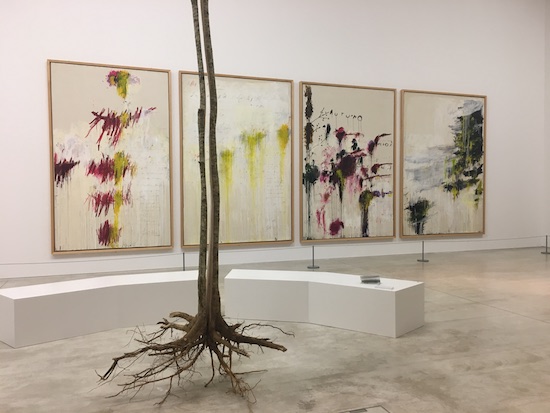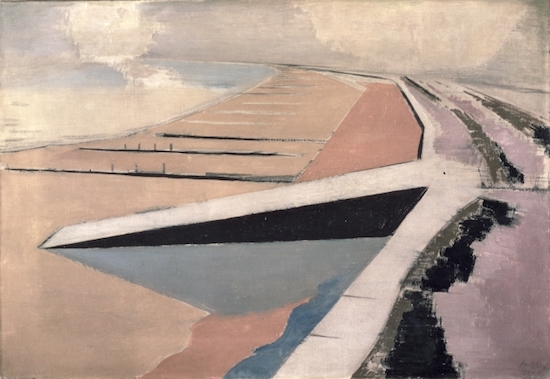The Shore, 1923 (oil on canvas), Nash, Paul (1889-1946) / Leeds Museums and Galleries (Leeds Art Gallery) U.K. / Bridgeman Images
Something quite beautiful is happening in Margate. In light of the anticipated, major exhibition at the Turner Contemporary, Journeys with the Waste Land, museums, galleries, theatres, studios, and coffee shops have followed suit, offering drawing and writing workshops, performances, interactive installations and exhibitions responding to T.S Eliot’s seminal poem, ‘The Waste Land’.
In 1921, Missouri born Eliot was thirty-three years-old and recovering from a breakdown. Mentally scarred by World War One and his emotionally unstable marriage, he was in Margate on leave from work at Lloyd’s Bank in London under doctors’ orders. He would continue to Sweden where he would receive treatment in the nascent field of psychotherapy. Daily, he sat in what we now know as the Victorian, Grade II listed Nayland Rock Shelter, looking out at the same sands and seascapes as one standing in the Turner Contemporary today. It was here that he composed much of his poem, which was to strike and compel his generation, shattered by the horror of war and the desolation of the nation left in its wake. “It is not a war poem as such, but rather concerned with an inner disintegration and cultural collapse – and we are no less of a collapsing and fractured culture than we were then.”
The Eliot celebration kicked off in the Pie Factory on the first day of February, with a painting exhibition by London-based Royal Drawing School graduates. As such a pioneering, visual poem, it is hard to find an artist who hasn’t spent time with it at some point in their artistic development. In the late eighteenth century, political theorist and philosopher of the sublime, Edmund Burke, identified that ambiguity was what made poetry powerful: “There are reasons in nature why the obscure idea, when properly conveyed, should be more affecting clear. It is our ignorance of things that causes all our admiration, and chiefly excites our passions”. The obscure narrative in poetry exists in much contemporary art practise – John Stezaker, featuring in the Turner Contemporary exhibition, specifically credits ‘The Waste Land’ for sparking his fascination with collage and the fragment – and these artists at the Pie Factory demonstrate this superbly.
The exhibition title borrows a line from the poem, ‘A Current Under Sea’. It is also the title of Elizabeth McCarten’s painting. McCarten described how she absorbed the poem and allowed it to influence her state of mind, resulting in this mysterious, transient scene. Alternatively Rebecca Harper’s piece Somewhere in the Middle is Where I Feel Comfortable can be read as a direct reference to Eliot’s fascination with the river Thames and a scene with a canoe. Katie Brookes empathised with Eliot’s experience of war and has created ‘collage paintings’ depicting imagery of conflicts closer to her lifetime, while Nikki Gardham’s fervent mark-making appears to capture an idea conjured from her personal fondness with particular lines from the poem. The fractured geometry and symbols of Leon Pozniakow’s unfolding, fantastical worlds glimpse at one another through doorways, carrying their excitable energy across the gallery in real space, just as the poem jumps from scene to scene. Alison Boult’s voyeuristic, deserted street in Night Walks is reminiscent of Edward Hopper, who features in the Turner Contemporary exhibition. Absent of any context to grasp the story it feels like the pauses in the poem. Kathryn Maple’s Ocotillo portrays cacti plants in a desert, but on blue paper. The surface becomes a portal, turning the desert into an ocean floor and the cactus into coral. It is their operating in the realms of ambiguity that makes these works powerful. The clarity is in what critic and playwright Sean O’Brian called their “coherence of sensation” and with that comes the power to stimulate the imagination.

Cy Twombly Four Seasons and Henrik Håkansson A Tree Divided
For this revolutionary exhibition, Turner Contemporary let go of curatorial direction and handed the reins over to The Waste Lands Research Group, consisting of eighty local residents who share an affinity with Eliot’s poem. They have been working together for the last three years to create this exhibition with Research Curator Trish Scott and Guest Curator Mike Tooby to draw out the themes of the poem through a duality of voices. “Turner Contemporary is a catalyst for the social and economic regeneration of Margate” Victoria Pompey OBE, Director of the Turner Contemporary tells me. “The project was designed to develop a pioneering approach to curating. The Research Group have reported a reduced sense of isolation and an increased sense of community.”
All the works have been selected by the Research Group, each member submitting one artwork that they personally connect with the poem. They have supported the journey of each piece, whether it be with loan arrangements from MoMA (for the Guston and the Hopper) or to work with artist Henrik Håkansson on the long, complex process to source a dying ash tree to then fell, root and split for A Tree Divided (Fraxinus excelsior) (2017), which was so worth the effort for the breath taking view as one enters the final room to witness its presence among Cy Twombly’s perfectly fitting Four Season (1993-5). It seems that for Twombly, like Eliot, “April is the cruellest month.”
In this multifaceted exhibition, the gallery is divided into four rooms, each taking a different stance on Eliot’s poem: it’s historical context born out of the ashes of the First World War, mental health and advances of technologies, the poem more literally as language and text, and contemporary artists responses. Each room offers audio points where one can listen to the knowledgeable and insightful research group discussing specific works, enabling a deeper engagement with the piece in question and the poem.
The journey begins by rooting us in historical and emotional context to help to embody some of the themes in the poem. Among the eclectic mix is Lee Miller, John Stezaker, Henry Moore, and Sir William Blake. Paul Nash and Olive Mudie Cooke set the scene with their achingly sad landscapes generated by their direct experiences of World War One. Nash’s Wire (1918) is mutated and hostile, devoid of hope and Mudie-Cooke’s lithograph Etaples: British Military Cemetery depicts crosses in the ground that mark the presence of the dead. This is “more than a wasteland. It is about brokenness – physically, morally, spiritually and culturally”. At a listening point the Research Group tell me that Cooke worked for the ambulance service, and took her own life as a result of what she saw.
As one moves further through the gallery, to enter the room of the Benedict Drew and Nicholas Brooks video installation, Sump, one first walks the gauntlet of portraits by Lalage Snow We Are The Not Dead, Returning By The Road We Came (2010), all of whom carry memories of first-hand experience of present day warfare. Sump hypnotically merges between tactile images of what could be aerial landscapes, patterns, and organic forms that are interior and bodily. It is mesmerising, presenting everything in its finest detail, and yet in its ambiguity it shows nothing. Imagination has the floor to fill the nonsensical gaps with its darkest thoughts. John Davies’ painting Night Through a Window (2005) does this in another way, by asking one to confront the isolation of a black void through a window.
One will always be able to inhabit the poem because it’s ambiguity of language collapses time. “This isn’t about the writer or someone else, it’s about you. In the now. You are breaking apart, transformed, fragmented.” This is literally the case as you catch sight of yourself in Monir Shahroudy Farmanfarmaian’s Variations on the Hexagon (2006) – an immersive, mirrored mosaic panel with blue glass and eye amulets, always operating in the present because it reflects and fragments the world and its viewer.
Eliot credited Jessie Western’s novel From Ritual to Romance (1920) for inspiration for the poem, which focuses on the motifs of the Holy Grail and the wasteland – a land under a curse in need of a saviour. Cecil Collins’ painting The Quest of 1938 has been linked to Eliot’s poem, as it portrays a king of sorts searching for rebirth to heal the land. It presents a question in crisis: “who is your leader?” the Wasteland Research Group ask, “It is a 1930’s to 2018 kind of issue.” Berny Tan presents A Visual Guide to References in T.S. Eliot’s The Waste Land (1922) (2011) offers a valuable insight into the meanings behind many of the lines in the poem. Rooted in mythology and antiquity, religion, post fourteenth-century literature, art, major historical events, culture and tradition, languages and real places, it will never date and it is never without its relevance, perfectly conveyed in this enlightening and thrilling exhibition.
‘Journeys with the Waste Land’ continues until 7th May 2018 at Turner Contemporary, Margate. Many other events inspired by the exhibition will continue through March, April and May.


